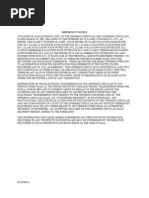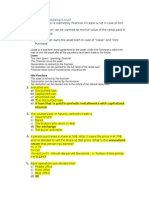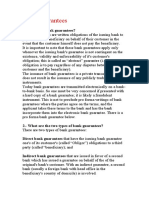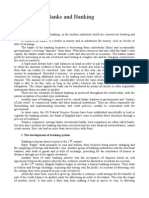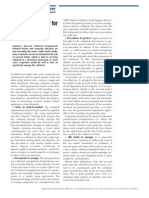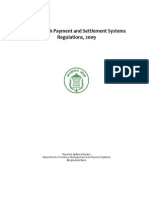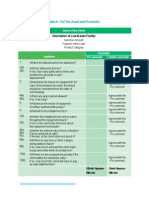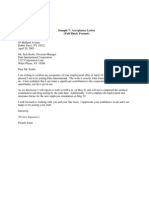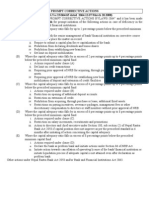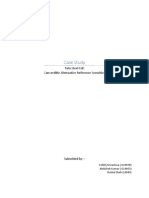0 ratings0% found this document useful (0 votes)
52 viewsForfaiting: Dr. Prashanta K. Banerjee
Forfaiting: Dr. Prashanta K. Banerjee
Uploaded by
nurul000Forfaiting refers to the non-recourse financing of long-term receivables such as promissory notes arising from international trade. It originated in Switzerland after WWII to provide financing for exports to Eastern Europe. Forfaiting involves a forfaiter purchasing trade bills or promissory notes from an exporter at a discount and collecting payment from the importer on the maturity date. The forfaiter assumes the credit risk of the importer rather than relying on the creditworthiness of the exporter. Forfaiting is typically used for medium to large export contracts of capital goods between 1-8 years in length. It provides exporters with financing without recourse to fluctuations in exchange rates or interest rates.
Copyright:
© All Rights Reserved
Available Formats
Download as DOC, PDF, TXT or read online from Scribd
Forfaiting: Dr. Prashanta K. Banerjee
Forfaiting: Dr. Prashanta K. Banerjee
Uploaded by
nurul0000 ratings0% found this document useful (0 votes)
52 views4 pagesForfaiting refers to the non-recourse financing of long-term receivables such as promissory notes arising from international trade. It originated in Switzerland after WWII to provide financing for exports to Eastern Europe. Forfaiting involves a forfaiter purchasing trade bills or promissory notes from an exporter at a discount and collecting payment from the importer on the maturity date. The forfaiter assumes the credit risk of the importer rather than relying on the creditworthiness of the exporter. Forfaiting is typically used for medium to large export contracts of capital goods between 1-8 years in length. It provides exporters with financing without recourse to fluctuations in exchange rates or interest rates.
Original Description:
Forfaiting
Original Title
Forfaiting New
Copyright
© © All Rights Reserved
Available Formats
DOC, PDF, TXT or read online from Scribd
Share this document
Did you find this document useful?
Is this content inappropriate?
Forfaiting refers to the non-recourse financing of long-term receivables such as promissory notes arising from international trade. It originated in Switzerland after WWII to provide financing for exports to Eastern Europe. Forfaiting involves a forfaiter purchasing trade bills or promissory notes from an exporter at a discount and collecting payment from the importer on the maturity date. The forfaiter assumes the credit risk of the importer rather than relying on the creditworthiness of the exporter. Forfaiting is typically used for medium to large export contracts of capital goods between 1-8 years in length. It provides exporters with financing without recourse to fluctuations in exchange rates or interest rates.
Copyright:
© All Rights Reserved
Available Formats
Download as DOC, PDF, TXT or read online from Scribd
Download as doc, pdf, or txt
0 ratings0% found this document useful (0 votes)
52 views4 pagesForfaiting: Dr. Prashanta K. Banerjee
Forfaiting: Dr. Prashanta K. Banerjee
Uploaded by
nurul000Forfaiting refers to the non-recourse financing of long-term receivables such as promissory notes arising from international trade. It originated in Switzerland after WWII to provide financing for exports to Eastern Europe. Forfaiting involves a forfaiter purchasing trade bills or promissory notes from an exporter at a discount and collecting payment from the importer on the maturity date. The forfaiter assumes the credit risk of the importer rather than relying on the creditworthiness of the exporter. Forfaiting is typically used for medium to large export contracts of capital goods between 1-8 years in length. It provides exporters with financing without recourse to fluctuations in exchange rates or interest rates.
Copyright:
© All Rights Reserved
Available Formats
Download as DOC, PDF, TXT or read online from Scribd
Download as doc, pdf, or txt
You are on page 1of 4
Forfaiting
Dr. Prashanta K. Banerjee
1. The term forfait is a French word, which means to give something or give up
ones right. Forfaiting refers to non-recourse financing of receivabes simiar to
factoring. !hie a factor norma" purchases a compan"s short-term receivabes,
a forfait ban# $ financia institution purchases trade bis$ promissor" notes that
are ong-term receivabes with ma%imum maturities of eight "ears. &t is on"
pertaining to internationa trade. Forfaiting had origina" deveoped in
'wit(erand after word war && in response to fet need for financing e%ports to the
)astern )urope for which financing was not avaiabe through the norma ban#ing
channes. *ow, goba", forfaiting voume stands at around +' , -. biion. &t
accounts for / 0. per cent of the tota internationa trade.
2. Forfaiting is we compared to e%port factoring with the difference that the
former finances notes$ bis arising out of deferred credit transactions for capita
goods spread over 1-2 "ears whereas factoring is essentia" a short-term
financing dea reating to the e%port of consumer goods. The forfaiting is a
hundred per cent financing arrangement on non-recourse basis. But the e%tent of
advance against receivabes with a factoring arrangement is on" partia, ranging
between 3.-2. per cent on recourse or without recourse basis. The forfaiters
decision to provide financing depends upon the financia standing of the avaiing
ban# whereas factors decision, particuar" in non-recourse, depends on the
credit standing of the e%porter. 4oreover, cost of forfaiting is eventua" borne b"
the overseas bu"er whereas in case of factoring it is usua" borne b" the seer.
---------------------------------------------------------------------------------------------------
5ssociate Professor, Bangadesh &nstitute of Ban# 4anagement
182
3. The mechanics of operation of forfaiting are presented in the following
Chart .
Mechanics of Forfaiting Transactions
Exporter 1 Importer
3
4 5 6 8 7 4
2
Exporters Bank Importer Bank
8 7
4 6
Forfaiter 8
5 7
4
Source: 4asarguppi, 5runa 6788/9, :5dvantage of Forfaiting, ;hartered
Financia 5na"st, *ovember, P.7. 6'ight" changed9.
79 ;ommercia contract between the e%porter and the importer.
-9 ;ommitment to forfait bis of e%change $ promissor" notes 6Debt instruments9.
19 Deiver" of goods b" the e%porter to the importer.
/9 Deiver" of debt instruments.
.9 )ndorsement of debt instruments without recourse in favour of the forfaiter.
<9 ;ash pa"ment of discounted debt instruments.
39 Presentation of debt instruments on maturit".
29 Pa"ment of debt instruments on maturit".
183
4. The benefits accruing to the e%porter are numerous. The e%porter receives the
fu e%port vaue minus the cost of forfaiting for credit transactions from the
forfaiter. !ith forfaiting, the e%porter can easi" avai credit periods of /-3 "ears .
The finance is provided without recourse. This means that the fuctuations in
interest rates and e%change rates do not matter during the commitment period.
The e%porter has, therefore, an assurance of receiving pa"ment notwithstanding
the ris#s regarding the bu"er, the bu"ers ban# and the bu"ers countr". The
e%porters botherations about administering the saes edger and coection of
pa"ments are aso ta#en over b" the forfaiter. This gives considerabe reief to
e%porters. 4oreover, the forfaiter does not insist on getting credit insurance from
officia agencies.
.. Forfaiting concudes the dea for the medium and arge e%port contract. The
internationa forfaiting agencies do not accept contracts to forfait bis ess than
=.. miion +' doars on a singe dea. &t is most" imited to capita goods. &t is
estimated that 2= to 2. per cent of the forfaiting mar#et toda" invoves the capita
goods e%porting . >owever, with growing e%ports, products i#e commodities,
eather, d"es, etc. are aso coming under the forfaiting umbrea. Forfaiting can be
used when ?overnment e%port credits or credit guarantees are not avaiabe. &t
aso hepfu for the sma si(ed companies because it enabes them to negotiate
transactions that norma" e%ceed their financia capabiities
<. Forfaiters are @uite active in Paris, ?eneva, Aienna, Brusses, etc . &n &ndia,
the )B&4 ban# has aread" received green signa from the CB& to faciitate e%port
financing through forfaiting. 4oreover, >ong Kong Ban#, 4eghraj Financia
'ervices, *atwest Ban#, &ndo 5va and 5B* 54CD Ban# offer forfaiting services
. 5ccording to their annua reports, the" have aread" faciitated forfaiting
services for commercia vehices, printed cotton fabrics, mechanica power
transmission, gems, etc. &n Bangadesh, forfaiting is "et to catch up. The main
reasons ma" be ac# of awareness among the e%porting communit", and itte
184
voume and ow amount of capita goods e%port. 4oreover, neither ?overnment
nor ban#s have ta#en an" step to aunch this e%port-promoting too.
3. For forfaiting to be successfu, e%istence of the secondar" mar#et is an
essentia condition. 5 forfaiter ma" not be incined to hod the discounted bis $
notes upto maturit" because of its own cash fow consideration. &n the secondar"
mar#et, forfaiters bu" and se these bis in the usua manner in which the
traditiona securities are traded. >owever, ever" transaction in the secondar"
mar#et is done on without recourse basis. &n that case, the hoder of the paper
6forfaited bi9 can go on" to the origina guarantor 6the ban#9 and not to the
previous forfait owner, or to the e%porter.
185
You might also like
- PrepartionDocument31 pagesPrepartionbaapanil100% (1)
- Explanation of SecuritizationDocument15 pagesExplanation of SecuritizationForeclosure Fraud100% (15)
- Class V III ProspectusDocument209 pagesClass V III ProspectusCarrieonicNo ratings yet
- BFS L0 QuesDocument360 pagesBFS L0 QuesShubhamKaseraNo ratings yet
- 15fighting ForeclosureDocument19 pages15fighting ForeclosureKeith Muhammad: Bey89% (9)
- Table of Contents Poultry Egg Farming Business PlanDocument3 pagesTable of Contents Poultry Egg Farming Business PlanGustafaGovachefMotivatiNo ratings yet
- What Is Meant by A Cross Border Doctrine'Document1 pageWhat Is Meant by A Cross Border Doctrine'Star RamirezNo ratings yet
- BNK601 Short NotesDocument7 pagesBNK601 Short NotesNasir MuhammadNo ratings yet
- Unctad - Marine Cargo Claims Adjustment and Recoveries - Old But GoldDocument17 pagesUnctad - Marine Cargo Claims Adjustment and Recoveries - Old But GoldRafa da PiliNo ratings yet
- Loans & Advances Basic Bank LTDDocument19 pagesLoans & Advances Basic Bank LTDZubair RazaNo ratings yet
- Deficit-Solution-Lies-In-Exports/ Text - 103644.html: C. GoldDocument17 pagesDeficit-Solution-Lies-In-Exports/ Text - 103644.html: C. GoldNikita NamaNo ratings yet
- F Exchange OkDocument22 pagesF Exchange OkZubair RazaNo ratings yet
- Basic Training Manual-For Retail Sales PersonnelDocument21 pagesBasic Training Manual-For Retail Sales Personnelmnasir_virgo14No ratings yet
- BFS L0 Ques464Document360 pagesBFS L0 Ques464Aayush AgrawalNo ratings yet
- Indian Banking SystemDocument8 pagesIndian Banking SystemAnonymous kwi5IqtWJNo ratings yet
- Banking and Insurance ServicesDocument68 pagesBanking and Insurance ServicesPowerCutPuneethNo ratings yet
- 15 Cebu Contractors v. CADocument4 pages15 Cebu Contractors v. CAJon SantosNo ratings yet
- Financial DerivativesDocument5 pagesFinancial Derivativessushant1903No ratings yet
- Guide To For Fa It IngDocument21 pagesGuide To For Fa It IngcristiansaitariuNo ratings yet
- Insurance Law: Sunlife Assurance, GR No. 158085, October 14, 2005)Document2 pagesInsurance Law: Sunlife Assurance, GR No. 158085, October 14, 2005)Sharmen Dizon GalleneroNo ratings yet
- Chapter Twenty-One Managing Liquidity Risk On The Balance SheetDocument15 pagesChapter Twenty-One Managing Liquidity Risk On The Balance SheetBiloni KadakiaNo ratings yet
- Meaning Bank GuaranteeDocument12 pagesMeaning Bank GuaranteemydeanzNo ratings yet
- Bonds and CourtsDocument2 pagesBonds and CourtsfiremanswifeNo ratings yet
- Report On FranchisingDocument3 pagesReport On Franchisingjimmyfunk56No ratings yet
- An Introduction To Contract AdministrationDocument3 pagesAn Introduction To Contract AdministrationjaffnaNo ratings yet
- Module 2.11 ForfaitingDocument33 pagesModule 2.11 ForfaitingdiviprabhuNo ratings yet
- Chapter 7 Revenue Recognition: Learning ObjectivesDocument16 pagesChapter 7 Revenue Recognition: Learning Objectivessamuel_dwumfourNo ratings yet
- Truth in Lending (RA 3765)Document2 pagesTruth in Lending (RA 3765)Solomon Malinias BugatanNo ratings yet
- BanksandbankingDocument6 pagesBanksandbankingRene Smith100% (2)
- Le Fax D'adamowiczDocument16 pagesLe Fax D'adamowiczLaurent MAUDUITNo ratings yet
- Lending OperationsDocument54 pagesLending OperationsFaraz Ahmed FarooqiNo ratings yet
- Reducinng Trasac Costs and Liquidity Insu EssaysDocument2 pagesReducinng Trasac Costs and Liquidity Insu EssaystlinhleworkNo ratings yet
- What Is Securitization2Document14 pagesWhat Is Securitization2John Foster100% (2)
- Credit Management BasicDocument8 pagesCredit Management BasicShohid ZamanNo ratings yet
- OutlineDocument33 pagesOutlineLisa Williams-McCallum100% (2)
- Treatment of Securitized Transactions in Bankruptcy: April 2001Document6 pagesTreatment of Securitized Transactions in Bankruptcy: April 2001Harpott GhantaNo ratings yet
- Collateral Support For DerivativesDocument2 pagesCollateral Support For DerivativesitreasurerNo ratings yet
- NOTESDocument8 pagesNOTESShruthi sNo ratings yet
- Lecture 08Document9 pagesLecture 08Faysal HaqueNo ratings yet
- Credit Policy GuidelinesDocument4 pagesCredit Policy Guidelinesnazmul099No ratings yet
- Leach TB Chap12 Ed3Document7 pagesLeach TB Chap12 Ed3bia070386No ratings yet
- Project Finance SchemeDocument7 pagesProject Finance SchemeLeilani JohnsonNo ratings yet
- 4) Net Working Capital:: Finance JargonsDocument4 pages4) Net Working Capital:: Finance JargonsnavyaekkiralaNo ratings yet
- Factoring in IndiaDocument16 pagesFactoring in IndiadaveferalNo ratings yet
- MBTC V BA Finance CorpDocument21 pagesMBTC V BA Finance CorpHeidiNo ratings yet
- BankingDocument1 pageBankingsarahmelgamilNo ratings yet
- Debt Instruments - FAQ: Personal FinanceDocument12 pagesDebt Instruments - FAQ: Personal FinanceparulshinyNo ratings yet
- Loss-Share Questions and AnswersDocument3 pagesLoss-Share Questions and Answersdbush2778No ratings yet
- Alternative Financing Products For SMEsDocument3 pagesAlternative Financing Products For SMEsrajmirakshanNo ratings yet
- CF Assignment - Group 2Document11 pagesCF Assignment - Group 2Poova RaghavanNo ratings yet
- MBNA Credit Card ABSDocument6 pagesMBNA Credit Card ABSOUSSAMA NASRNo ratings yet
- OTC Derivatives General Paper 112010 AaaaDocument5 pagesOTC Derivatives General Paper 112010 Aaaaredearth2929No ratings yet
- Corporate FinanceDocument3 pagesCorporate Financeomar.yasser2014omarNo ratings yet
- ForfaitingDocument14 pagesForfaitingArun SharmaNo ratings yet
- Tenielle Appanna - The Two Important Doctrines Underlying Documentary Letters of Credit and The Fraud ExceptionDocument12 pagesTenielle Appanna - The Two Important Doctrines Underlying Documentary Letters of Credit and The Fraud ExceptionRoy BhardwajNo ratings yet
- Letters of CreditDocument4 pagesLetters of CreditNahid Ali Mosleh JituNo ratings yet
- Trade ServicesDocument4 pagesTrade ServicesHabib KhanNo ratings yet
- G.R. No. 161135. April 8, 2005 Swagman Hotels and Travel, Inc., Petitioners, Hon. Court of Appeals, and Neal B. Christian, RespondentsDocument6 pagesG.R. No. 161135. April 8, 2005 Swagman Hotels and Travel, Inc., Petitioners, Hon. Court of Appeals, and Neal B. Christian, RespondentsJenMarkNo ratings yet
- Chapter 7 Accounting For Provisions, Contingencies and Events After The Reporting PeriodDocument30 pagesChapter 7 Accounting For Provisions, Contingencies and Events After The Reporting Periodsamuel_dwumfourNo ratings yet
- Stamp RequisitionDocument20 pagesStamp Requisitionnurul000No ratings yet
- Name Change - Feb032019dfiml01Document1 pageName Change - Feb032019dfiml01nurul000No ratings yet
- Vehicle Requisition FormDocument1 pageVehicle Requisition Formnurul000No ratings yet
- Cheque Clearing FeeDocument1 pageCheque Clearing Feenurul000No ratings yet
- Driving Digital Innovation For A Sustainable Inclusive GrowthDocument209 pagesDriving Digital Innovation For A Sustainable Inclusive Growthnurul000100% (1)
- Appointment of External Auditors in Financial Institutions - Apr302015dfim04eDocument3 pagesAppointment of External Auditors in Financial Institutions - Apr302015dfim04enurul000No ratings yet
- Write Off - Apr082015fid03Document1 pageWrite Off - Apr082015fid03nurul000No ratings yet
- Avoidance of High Expenses For Luxurious Vehicles and Decoration - Nov182015dfim12eDocument1 pageAvoidance of High Expenses For Luxurious Vehicles and Decoration - Nov182015dfim12enurul000No ratings yet
- Application - Form of BkmeaDocument3 pagesApplication - Form of Bkmeanurul000No ratings yet
- Sep182018dfim03Document4 pagesSep182018dfim03nurul000No ratings yet
- An Overview of ITPFDocument3 pagesAn Overview of ITPFnurul000No ratings yet
- Payment Settlements R 2009Document8 pagesPayment Settlements R 2009nurul000No ratings yet
- Rate of Interest PhonixDocument1 pageRate of Interest Phonixnurul000No ratings yet
- Bank Asia ATM LocationsDocument4 pagesBank Asia ATM Locationsnurul000No ratings yet
- The Bankers' Book Evidence Act, 1891Document4 pagesThe Bankers' Book Evidence Act, 1891nurul000No ratings yet
- Table-A: CAF (For Asset-Side Products) : Description of Loan/Lease FacilityDocument4 pagesTable-A: CAF (For Asset-Side Products) : Description of Loan/Lease Facilitynurul000No ratings yet
- ALM Maturity Profile 1Document8 pagesALM Maturity Profile 1nurul000No ratings yet
- United Commercial Bank LTD: For The Year Ended 31st December 2005Document1 pageUnited Commercial Bank LTD: For The Year Ended 31st December 2005nurul000No ratings yet
- Sample 7: Acceptance Letter (Full Block Format) : (Written Signature)Document1 pageSample 7: Acceptance Letter (Full Block Format) : (Written Signature)nurul000No ratings yet
- FM-Math, Time Value of MoneyDocument2 pagesFM-Math, Time Value of Moneynurul000No ratings yet
- Know Your Marketability Know Your Marketability Know Your Marketability Know Your MarketabilityDocument22 pagesKnow Your Marketability Know Your Marketability Know Your Marketability Know Your Marketabilitynurul000No ratings yet
- Schedule of Charges Credit CardDocument2 pagesSchedule of Charges Credit Cardnurul000No ratings yet
- CFP - Module 1 - IIFP - StudentsDocument269 pagesCFP - Module 1 - IIFP - StudentsmodisahebNo ratings yet
- Lecture 3Document13 pagesLecture 3Ankur ChughNo ratings yet
- Aqua Ar08 PDFDocument96 pagesAqua Ar08 PDFTens GravyNo ratings yet
- Jurnal Ekonomi Islam Al-Infaq Vol. 2 No. 2 September 2011Document96 pagesJurnal Ekonomi Islam Al-Infaq Vol. 2 No. 2 September 2011Ahm Nur DausNo ratings yet
- Daily Calling ListDocument522 pagesDaily Calling ListDhananjayan Gopinathan100% (1)
- Know When To Buy or Sell A Currency Pair PDFDocument5 pagesKnow When To Buy or Sell A Currency Pair PDFThines KumarNo ratings yet
- CLSS EWS LIG English Guidelines WBDocument36 pagesCLSS EWS LIG English Guidelines WBAnurag BabuNo ratings yet
- Answers To Quiz No 13Document4 pagesAnswers To Quiz No 13Your Public Profile100% (1)
- Notes Ica and SogaDocument38 pagesNotes Ica and SogahaloXDNo ratings yet
- Meaning of A CompanyDocument28 pagesMeaning of A CompanyAman GautamNo ratings yet
- Hugh Hendry: Hugh Hendry (Born March 1969) Is The Founding Partner And, at VariousDocument3 pagesHugh Hendry: Hugh Hendry (Born March 1969) Is The Founding Partner And, at VariousAbdullah18No ratings yet
- Escalation MatrixDocument2 pagesEscalation MatrixAnurag SinghNo ratings yet
- A Project Report On "Motilal Oswal Financial Service LTD"Document61 pagesA Project Report On "Motilal Oswal Financial Service LTD"Aman BasantwaniNo ratings yet
- Ross Chapter 9 NotesDocument11 pagesRoss Chapter 9 NotesYuk Sim100% (1)
- Education National Management College (Myanmar)Document3 pagesEducation National Management College (Myanmar)Adam100% (1)
- Capital Market OperationsDocument24 pagesCapital Market Operationss harsha vardhanNo ratings yet
- Annual Report of Lafarge Surma Cement 2012 BangladeshDocument161 pagesAnnual Report of Lafarge Surma Cement 2012 BangladeshAnonymous okVyZFmqqXNo ratings yet
- Prompt Corrective ActionsDocument1 pagePrompt Corrective Actionsnir_lord100% (1)
- Creating Customer Value: Icici BankDocument18 pagesCreating Customer Value: Icici BanksheetalNo ratings yet
- Chapter - 20 To 25 PDFDocument113 pagesChapter - 20 To 25 PDFRupinder kaurNo ratings yet
- Fundamental Analysis of Telecom SectorDocument73 pagesFundamental Analysis of Telecom SectorArun Thakur75% (8)
- Donald C Nugent Financial Disclosure Report For 2009Document6 pagesDonald C Nugent Financial Disclosure Report For 2009Judicial Watch, Inc.No ratings yet
- Working Capital ManagementDocument78 pagesWorking Capital ManagementDrj Maz50% (2)
- Business Finance: Need and ImportanceDocument2 pagesBusiness Finance: Need and ImportanceKris YifanNo ratings yet
- Risk CalculationDocument6 pagesRisk CalculationvvpvarunNo ratings yet
- 8918 Business Combination NOTES Live Chat PDFDocument4 pages8918 Business Combination NOTES Live Chat PDFGlayca PallerNo ratings yet
- Case Study: Tata Steel LTD: Convertible Alternative Reference SecuritiesDocument5 pagesCase Study: Tata Steel LTD: Convertible Alternative Reference SecuritiesKshitij Srivastava100% (1)


